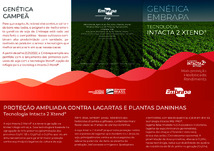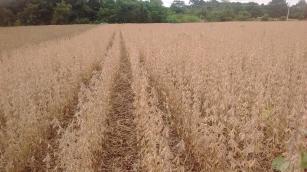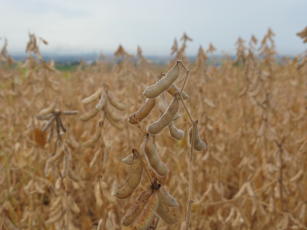First soybean cultivars with Xtend technology to be launched by Embrapa and Meridional
First soybean cultivars with Xtend technology to be launched by Embrapa and Meridional
The first soybean cultivars with the technology Xtend® - BRS 2553XTD and BRS 2558XTD - by Embrapa, in partnership with the Meridional Foundation, are a refuge option for the technology Intacta 2Xtend® and were launched on an online Field Day, on March 25. The cultivars offer tolerance to the herbicides dicamba and glyphosate, making weed management more flexible. On the other hand, the technology Intacta 2Xtend® adds three proteins (pyramided proteins Cry1A.105, Cry2Ab2 and Cry1Ac) that work to ensure protection against the main caterpillars that attack soybean crops.
Using Xtend® cultivars in refuge areas is a prevention measure to avoid resistance to caterpillars and extend the technology Intacta 2Xtend® half life. The refuge consists in sowing plots with the Xtend® technology or other non-Bt soybeans at a distance of at most 800m from plots with the Intacta 2Xtend® technology.
Launch of BRS 2553XTD
BRS 2553XTD is a cultivar that can be used in refuge areas for cultivars with I2X technology. It has high production performance, associated with precocity (maturity group 5.3). “It is the earliest cultivar in Embrapa's portfolio and, since it combines precocity with good branching, it can produce more pods, ensuring excellent yield. Plant architecture is also a high point because it favors the application and penetration of chemical products”, states researcher Carlos Lásaro Pereira de Melo.
BRS 2553XTD is recommended for Rio Grande do Sul, Paraná and Santa Catarina (a region known as REC 102), especially at altitudes above 700 meters. “In such regions, production potential is increased and can even reach over 5,000 kilos per hectare, which exceeds the different standards with which it has been compared in the market”, he asserts.
Another relevant characteristic of BRS 2553XTD is resistance to Phytophthora root rot, a disease caused by this soil fungus that has caused major economic losses to infected crops. It is also resistant to stem canker, frogeye leaf spot and soybean mosaic virus; moderately resistant to powdery mildew, and tolerant to cowpea mild mottle virus.
Launch of BRS 2558XTD
BRS 2558XTD is another cultivar that can be used in refuge areas for cultivars with I2X. The early cultivar (maturity group 5.8) is recommended for Rio Grande do Sul, Paraná and São Paulo (REC 103). Due to the new plant's cycle, the cultivar suits anticipated sowing, as it can be sown from September on, right after the sanitary break. “It is a great option for early cultivation, as it is adapted to anticipated sowing, allowing it to fit into crop succession/rotation systems, such as beans or second-season corn”, underscores researcher Carlos Lásaro Pereira de Melo.
Another high point of the cultivar is its excellent production potential, which, in combination with good plant branching, surpasses the yield standards set by the most productive cultivars on the market. “During the assessments, BRS 2558XTD showed potential above 5,000 kilos per hectare, which is quite relevant when compared to other cultivars”, the researcher observes.
The cultivar features its good health, especially its resistance to Phytophthora root rot. “This trait adds greater stability in case the disease manifests itself, because the plants are not affected, unlike susceptible cultivars”, Melo states. It is also resistant to stem canker, soybean mosaic virus and moderately resistant to frogeye leaf spot.
BRS 2558XTD has an average protein content of around 40%, while the Brazilian average is 36%. Therefore, it offers expressive gains for the Brazilian agroindustry sector that produces animal feed.
Valuing innovations and technology
"In the course of 22 years of partnership with Embrapa, the Meridional Foundation has developed a large portfolio of cultivars in different soybean breeding platforms. We have great expectations for these new technologies", comments Ralf Udo Dengler, executive manager of the Meridional Foundation.
“The cultivars with Xtend® technology BRS 2553XTD and BRS 2558XTD have already been signed up for fields in the 21/22 crop seasons and we should expand the offer for the next harvest, when we should also launch other XTD cultivars, as well as the first cultivars with Intacta 2 Xtend® technology”, Dengler states.
Enhanced protection against caterpillars
The Intacta 2 Xtend® soybean plant offers protection against six species of caterpillars that affect the soybean crop, namely Helicoverpa armigera and Spodoptera cosmioides, in addition to the four others that were already the target of the Intacta RR2 PRO®, soybean looper (Chrysodeixis includens), velvetbean caterpillar (Anticarsia gemmatalis), tobacco budworm (Chloridea virescens), and Neotropical soybean budborer (Crocidosema aporema). “The pyramiding of two proteins, combined with Cry1Ac, in this technology, reduces the probability of breaking the resistance of the first generation Bt (Cry1Ac)”, explains researcher Daniel Sosa Gomez, from Embrapa Soybeans.
Embrapa defends that pest management in crops with the Intacta 2 Xtend® technology follows the same premises as Integrated Pest Management (IPM), such as monitoring and control when pests reach the level of action, giving priority to selective insecticides. “A fundamental aspect to avoid the selection of populations of resistant caterpillars in crops with this technology is the planting of structured refuge areas”, explains Sosa Gomez.
The current refuge recommendation for soybean cultivation is that at least 20% of the area is covered with other technology than Intacta 2Xtend®. According to the researcher, this is a preventive measure that consists of sowing croplands with the Intacta 2Xtend® technology at a maximum distance of 800 meters from crops with Xtend® technology or from other non-Bt soybean options (RR or conventional soybeans require greater caution during dicamba applications).
“This distance allows the random mating of moths from areas with Intacta 2 Xtend technology and refuge areas, with subsequent maintenance of susceptible populations and delaying the selection of resistant populations”, he states.
Weed management and dicamba applications
Soybean cultivars with the Intacta 2 Xtend® and Xtend® technologies are tolerant to the herbicide dicamba, which efficiently manages broad-leaved weeds like como a buva, o caruru, a corda-de-viola, o picão-preto, dentre outras, underscores Dionísio Gazziero, an Embrapa Soybeans researcher.
The researcher calls farmers to heed the emergence or dissemination of resistant weeds. In addition, he recalls that integrated management practices involves not only chemical control, but also the rotation of herbicide action mechanisms, crop rotation - at least in-between soybean harvests - the use of species to produce good stubble, cleaning agricultural machinery and implements, using weed-free seeds and monitoring flora changes to prevent the reproduction of these species.
The association of dicamba with glyphosate is another alternative available in the market to solve problems with weeds, but it is necessary to use the products correctly”, he stresses. “Dicamba is recommended for pre-sowing application in soybean plantations. It is essential that the information contained in the package insert is followed, as non-compliance with technical guidelines can harm non-target crops”, Gazziero concludes. More information about the cultivars and this new technology can be obtained on www.embrapa.br/soja/cultivares.
Lebna Landgraf (MTb 2903/PR)
Embrapa Soybeans
Press inquiries
soja.imprensa@embrapa.br
Phone number: +55 43 3371-6061
Translation: Mariana Medeiros (13044/DF)
General Secretariat
Further information on the topic
Citizen Attention Service (SAC)
www.embrapa.br/contact-us/sac/




